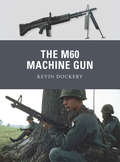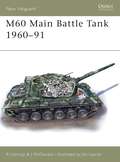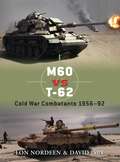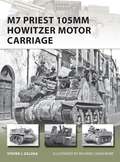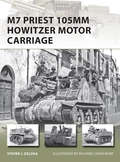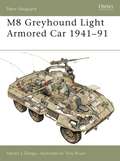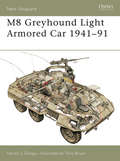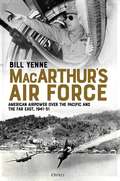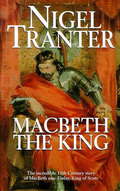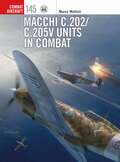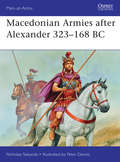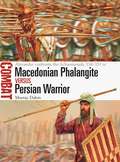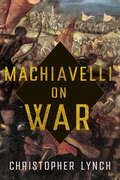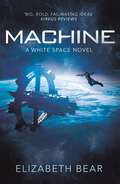- Table View
- List View
The M60 Machine Gun (Weapon)
by Kevin Dockery Mark Stacey Alan GillilandThe US M60 General Purpose Machine Gun, known as "the Pig,†? was developed in the years after World War II from two revolutionary German designs. Adopted in 1957, the M60 came into its own in the jungles, hamlets, and city streets of Southeast Asia during the Vietnam War. "Humping the Pig†? became common in US military squads, with at least one soldier equipped with an M60 and every squad member carrying ammunition for it. The M60 design transformed infantry tactics as squads took advantage of the immediate volume of fire offered by the design. Although it has now been replaced by the M240 series of weapons in US infantry and mechanized units, the M60 is still in common use with the US armed forces. Meanwhile, its iconic status has been assured by its frequent appearance in many popular films and television shows, from Full Metal Jacket to The A Team. Featuring specially commissioned full-color artwork, this is the full story of the M60, the innovative squad base-of-fire weapon that has equipped the US military from the jungles of Vietnam to the deserts of Iraq.
The M60 Machine Gun (Weapon #20)
by Kevin Dockery Mark Stacey Alan GillilandThe US M60 General Purpose Machine Gun, known as "the Pig,†? was developed in the years after World War II from two revolutionary German designs. Adopted in 1957, the M60 came into its own in the jungles, hamlets, and city streets of Southeast Asia during the Vietnam War. "Humping the Pig†? became common in US military squads, with at least one soldier equipped with an M60 and every squad member carrying ammunition for it. The M60 design transformed infantry tactics as squads took advantage of the immediate volume of fire offered by the design. Although it has now been replaced by the M240 series of weapons in US infantry and mechanized units, the M60 is still in common use with the US armed forces. Meanwhile, its iconic status has been assured by its frequent appearance in many popular films and television shows, from Full Metal Jacket to The A Team. Featuring specially commissioned full-color artwork, this is the full story of the M60, the innovative squad base-of-fire weapon that has equipped the US military from the jungles of Vietnam to the deserts of Iraq.
M60 Main Battle Tank 1960–91 (New Vanguard #85)
by Jim Laurier Richard Lathrop John McDonaldEntering service in the early 1960s, the M60 tank was in production for 23 years and formed the backbone of US Army and Marine armoured units during the Cold War. Over 15,000 were built in four basic models: the M60, M60A1, M60A2, and the M60A3. Although the M60 had been phased out of US Army service by the time Iraq invaded Kuwait in 1990, M60s were amongst the first Allied tanks to enter Kuwait City with the US Marines. This book examines the design and deployment of the M60, a very widely used vehicle that is still in service today.
M60 Main Battle Tank 1960–91 (New Vanguard #85)
by Jim Laurier Richard Lathrop John McDonaldEntering service in the early 1960s, the M60 tank was in production for 23 years and formed the backbone of US Army and Marine armoured units during the Cold War. Over 15,000 were built in four basic models: the M60, M60A1, M60A2, and the M60A3. Although the M60 had been phased out of US Army service by the time Iraq invaded Kuwait in 1990, M60s were amongst the first Allied tanks to enter Kuwait City with the US Marines. This book examines the design and deployment of the M60, a very widely used vehicle that is still in service today.
M60 vs T-62: Cold War Combatants 1956–92 (Duel #30)
by Richard Chasemore David Isby Lon NordeenDesigned for the battlefields of Europe at the height of the Cold War, the M60 and T-62 were the premier combat tanks of their day. However, it was in the deserts of the Middle East that they finally met in battle. This new Duel title examines the design and development of these main battle tanks, identifying their strengths and weaknesses, and describing and analyzing their performance on the battlefield during the Yom Kippur War, the Iran–Iraq War, and the first Gulf War.
M60 vs T-62: Cold War Combatants 1956–92 (Duel #30)
by Richard Chasemore David Isby Lon NordeenDesigned for the battlefields of Europe at the height of the Cold War, the M60 and T-62 were the premier combat tanks of their day. However, it was in the deserts of the Middle East that they finally met in battle. This new Duel title examines the design and development of these main battle tanks, identifying their strengths and weaknesses, and describing and analyzing their performance on the battlefield during the Yom Kippur War, the Iran–Iraq War, and the first Gulf War.
M7 Priest 105mm Howitzer Motor Carriage (New Vanguard #201)
by Steven J. Zaloga Richard ChasemoreBased upon the ubiquitous Grant/Sherman tank, the M7 Priest is the iconic Allied self-propelled howitzer. It was the most widely manufactured vehicle of its type in World War ll and was utilized by the US, British, Canadian and Free French forces. Its combat debut was with Montgomery's Eight Army at El Alamein and it fought subsequently in every major campaign through Sicily, Italy, Normandy and the final battles in Germany. In addition to covering all variants of the Priest, this book also looks at the major derivatives, including the British/Canadian Sexton and the US M12 155mm GMC.
M7 Priest 105mm Howitzer Motor Carriage (New Vanguard #201)
by Steven J. Zaloga Richard ChasemoreBased upon the ubiquitous Grant/Sherman tank, the M7 Priest is the iconic Allied self-propelled howitzer. It was the most widely manufactured vehicle of its type in World War ll and was utilized by the US, British, Canadian and Free French forces. Its combat debut was with Montgomery's Eight Army at El Alamein and it fought subsequently in every major campaign through Sicily, Italy, Normandy and the final battles in Germany. In addition to covering all variants of the Priest, this book also looks at the major derivatives, including the British/Canadian Sexton and the US M12 155mm GMC.
M8 Greyhound Light Armored Car 1941–91 (New Vanguard)
by Steven J. Zaloga Tony BryanThe M8 light armored car was the only significant wheeled combat vehicle used by the US Army in World War II. In conjunction with the lightly armed utility version, the M20, it was the staple of the army's cavalry squadrons for use in reconnaissance and scouting. First entering combat in Italy in 1943, it was widely used throughout the campaign in northwest Europe, though its off-road performance was found to be wanting. This title describes the design and development of the M8, covering the many variants that were produced during World War II and afterwards, along with a comprehensive survey of its operational use.
M8 Greyhound Light Armored Car 1941–91 (New Vanguard #53)
by Steven J. Zaloga Tony BryanThe M8 light armored car was the only significant wheeled combat vehicle used by the US Army in World War II. In conjunction with the lightly armed utility version, the M20, it was the staple of the army's cavalry squadrons for use in reconnaissance and scouting. First entering combat in Italy in 1943, it was widely used throughout the campaign in northwest Europe, though its off-road performance was found to be wanting. This title describes the design and development of the M8, covering the many variants that were produced during World War II and afterwards, along with a comprehensive survey of its operational use.
Mabel's War: Love and Hope Beyond the Blitz
by Mabel HewittWITH devastating clarity and gentle humour, Mabel Hewitt takes us through her extraordinary life, from her childhood in the shadow of the First World War right up to the present day. Born in the tumultuous thirties, when the threat of the poorhouse hung over working families, she was just 10 years old when war clouds began to gather across Europe. She remembers air-raid sirens, taking shelter underground with her mother and sisters, and the utterly terrifying Coventry Blitz, when almost two-thirds of the city was destroyed or damaged.And yet, despite everything, her spirit shines through. Mabel’s War is a poignant account of love and hope during some of the country’s darkest days.
MacArthur at War: World War II in the Pacific
by Walter R. BornemanThe definitive account of General Douglas MacArthur's rise during World War II, from the author of the bestseller The Admirals. World War II changed the course of history. Douglas MacArthur changed the course of World War II. Macarthur at War will go deeper into this transformative period of his life than previous biographies, drilling into the military strategy that Walter R. Borneman is so skilled at conveying, and exploring how personality and ego translate into military successes and failures. Architect of stunning triumphs and inexplicable defeats, General MacArthur is the most intriguing military leader of the twentieth century. There was never any middle ground with MacArthur. This in-depth study of the most critical period of his career shows how his influence spread far beyond the war-torn Pacific. A Finalist for the Gilder Lehrman Prize for Military History at the New York Historical Society
MacArthur in Asia: The General and His Staff in the Philippines, Japan, and Korea
by Hiroshi Masuda"Hiroshi Masuda reinterprets MacArthur by going back to his years in the Philippines. In particular, [the book] focuses on the ‘Bataan Boys,’ the group of subordinates who accompanied MacArthur in his 1942 evacuation from the Philippines, and their views of MacArthur. MacArthur in Asia offers valuable insights into not only MacArthur’s public persona but also his personal and human characteristics, demonstrating the strengths of the biographical approach to historical scholarship."—Asahi Shimbun "This book offers an integrated view that links wartime and postwar Japan through the figure of one person, Douglas MacArthur. The Occupation appears as an extension of the war, and we are left with the historical awareness that, in East Asia, war continued even after 1945."—Tokyo ShimbunGeneral Douglas MacArthur’s storied career is inextricably linked to Asia. His father, Arthur, served as Military Governor of the Philippines while Douglas was a student at West Point, and the younger MacArthur would serve several tours of duty in that country over the next four decades, becoming friends with several influential Filipinos, including the country’s future president, Emanuel L. Quezon. In 1935, he became Quezon’s military advisor, a post he held after retiring from the U.S. Army and at the time of Japan’s invasion of 1941. As Supreme Commander for the Southwest Pacific, MacArthur led American forces throughout the Pacific War. He officially accepted Japan's surrender in 1945 and would later oversee the Allied occupation of Japan from 1945 to 1951. He then led the UN Command in the Korean War from 1950 to 1951, until he was dismissed from his post by President Truman.In MacArthur in Asia, the distinguished Japanese historian Hiroshi Masuda offers a new perspective on the American icon, focusing on his experiences in the Philippines, Japan, and Korea and highlighting the importance of the general’s staff—the famous "Bataan Boys" who served alongside MacArthur throughout the Asian arc of his career—to both MacArthur’s and the region’s history. MacArthur implemented far-reaching democratic reforms under the Occupation. MacArthur's policy and view on the reforms are eloquently described based on Masuda's thorough studies. First published to wide acclaim in Japanese in 2009 and translated into English for the first time, this book uses a wide range of sources—American and Japanese, official records and oral histories—to present a complex view of MacArthur, one that illuminates his military decisions during the Pacific campaign and his administration of the Japanese Occupation.
MacArthur’s Air Force: American Airpower over the Pacific and the Far East, 1941–51
by Bill YenneGeneral Douglas MacArthur is one of the towering figures of World War II, and indeed of the twentieth century, but his leadership of the second largest air force in the USAAF is often overlooked. When World War II ended, the three numbered air forces (the Fifth, Thirteenth and Seventh) under his command possessed 4,004 combat aircraft, 433 reconnaissance aircraft and 922 transports. After being humbled by the Japanese in the Philippines in 1942, MacArthur and his air chief General George Kenney rebuilt the US aerial presence in the Pacific, helping Allied naval and ground forces to push back the Japanese Air Force, re-take the Philippines, and carry the war north towards the Home Islands. Following the end of World War II MacArthur was the highest military and political authority in Japan, and at the outbreak of the Korean War in June 1950 he was named as Commander in Chief, United Nations Command. In the ten months of his command his Far East Air Forces increased dramatically and saw the first aerial combat between jet fighters. Written by award-winning aviation historian Bill Yenne, this engrossing book traces the journey of American air forces in the Pacific under General MacArthur's command, from their lowly beginnings to their eventual triumph over Imperial Japan, followed by their entry into the jet age in the skies over Korea.
MacArthur’s Air Force: American Airpower over the Pacific and the Far East, 1941–51
by Bill YenneGeneral Douglas MacArthur is one of the towering figures of World War II, and indeed of the twentieth century, but his leadership of the second largest air force in the USAAF is often overlooked. When World War II ended, the three numbered air forces (the Fifth, Thirteenth and Seventh) under his command possessed 4,004 combat aircraft, 433 reconnaissance aircraft and 922 transports. After being humbled by the Japanese in the Philippines in 1942, MacArthur and his air chief General George Kenney rebuilt the US aerial presence in the Pacific, helping Allied naval and ground forces to push back the Japanese Air Force, re-take the Philippines, and carry the war north towards the Home Islands. Following the end of World War II MacArthur was the highest military and political authority in Japan, and at the outbreak of the Korean War in June 1950 he was named as Commander in Chief, United Nations Command. In the ten months of his command his Far East Air Forces increased dramatically and saw the first aerial combat between jet fighters. Written by award-winning aviation historian Bill Yenne, this engrossing book traces the journey of American air forces in the Pacific under General MacArthur's command, from their lowly beginnings to their eventual triumph over Imperial Japan, followed by their entry into the jet age in the skies over Korea.
Macau in the Second World War, 1937-1945: Diplomacy, Politics and Society
by Sonny Shiu-Hing LoThis book offers a re-interpretation of the political history of Macau from 1937 to 1945, during which Japan and China were engulfed in the Second World War. Using an array of English and Chinese sources, the author explores the diplomatic and social landscape of war-time Macau under Portuguese colonial rule. By framing this analysis within the concept of Portuguese ‘neutrality’, the book builds on the political history of Macau and provides new insights into the role of Japanese collaborators and Communist guerrillas. Seeking to answer important questions such as why Macau was not invaded by Japan in the Second World War, and what role the Nationalist Party Government played during this period, this book presents a new approach to examining Macau’s diplomatic history. A unique read for scholars of Chinese history, this book will also appeal to those researching diplomatic and political history during the Second World War.
Macbeth the King
by Nigel TranterAcross a huge colourful canvas, ranging from the wilds of Scotland toNorway, Denmark and Rome, here is the story of the real MacBeth.Set aside Shakespeare's portrait: read instead of his struggle to makeand save a united Scotland.In this impressively researched and vivid portrayal, Tranter belies thepopular perception of a savage, murderous ambitious king. Instead, hetells of MacBeth's struggle to make and save a united Scotland; hisdevotion to his great love, the young Queen Gruoch; the humane laws theyfought for; the great battle they were forced to fight. And the terribleprice they paid.
Macchi C.202/C.205V Units in Combat (Combat Aircraft)
by Marco MattioliA study of the Macchi Folgore and Veltro, the most successful Italian fighters in World War II. With specially commissioned profiles, the book examines how these fighters were conceived, their performance and the fascinating stories of their pilots.Italian fighters, such as the Fiat G.50 and Macchi C.200, had always struggled with their straight-line speed and restricted armament when engaging their Allied counterparts. To solve these problems, Macchi initially designed the C.202 Folgore using German engines, which contributed to create a faster aircraft, with a superior rate of climb and reachable altitude. Folgore's success in various North African engagements then paved the way for the development of Macchi's most successful fighter, the C.205V Veltro, which managed to combine increased speed and increased power. Packed with specially commissioned artwork and original photos, and written by Italian military aviation specialist Marco Mattioli, this fascinating book explores how the premier Italian fighter of the war came to life and the historical circumstances that prevented it from becoming one of the most dreaded aircraft in the Mediterranean.
Macchi C.202/C.205V Units in Combat (Combat Aircraft)
by Marco MattioliA study of the Macchi Folgore and Veltro, the most successful Italian fighters in World War II. With specially commissioned profiles, the book examines how these fighters were conceived, their performance and the fascinating stories of their pilots.Italian fighters, such as the Fiat G.50 and Macchi C.200, had always struggled with their straight-line speed and restricted armament when engaging their Allied counterparts. To solve these problems, Macchi initially designed the C.202 Folgore using German engines, which contributed to create a faster aircraft, with a superior rate of climb and reachable altitude. Folgore's success in various North African engagements then paved the way for the development of Macchi's most successful fighter, the C.205V Veltro, which managed to combine increased speed and increased power. Packed with specially commissioned artwork and original photos, and written by Italian military aviation specialist Marco Mattioli, this fascinating book explores how the premier Italian fighter of the war came to life and the historical circumstances that prevented it from becoming one of the most dreaded aircraft in the Mediterranean.
Macedonian Armies after Alexander 323–168 BC (Men-at-Arms)
by Peter Dennis Nicholas SekundaThe death of Alexander the Great in 323 BC threw the Macedonians into confusion; there was no capable heir, and no clear successor among the senior figures in Alexander's circle. Initial attempts to preserve the unity of Alexander's conquests gave way to a period of bloody and prolonged warfare. For well over a century the largely mercenary armies of Alexander's successors imposed their influence over the whole of the Near East, while absorbing local military practices. After Rome's decisive defeat of Carthage in 202 BC, Macedonia came under increasing pressure from the Romans. Three wars between the two powers culminated in the Roman victory at Pydna in 168 BC, which laid Alexander's empire to rest and established Roman hegemony in the Near East. Drawing upon a wide array of archaeological and written sources and written by a noted authority on the Hellenistic period, this survey of the organization, battle history and appearance of the armies of Alexander's successors is lavishly illustrated with specially commissioned full-colour artwork.
Macedonian Armies after Alexander 323–168 BC (Men-at-Arms)
by Peter Dennis Nicholas SekundaThe death of Alexander the Great in 323 BC threw the Macedonians into confusion; there was no capable heir, and no clear successor among the senior figures in Alexander's circle. Initial attempts to preserve the unity of Alexander's conquests gave way to a period of bloody and prolonged warfare. For well over a century the largely mercenary armies of Alexander's successors imposed their influence over the whole of the Near East, while absorbing local military practices. After Rome's decisive defeat of Carthage in 202 BC, Macedonia came under increasing pressure from the Romans. Three wars between the two powers culminated in the Roman victory at Pydna in 168 BC, which laid Alexander's empire to rest and established Roman hegemony in the Near East. Drawing upon a wide array of archaeological and written sources and written by a noted authority on the Hellenistic period, this survey of the organization, battle history and appearance of the armies of Alexander's successors is lavishly illustrated with specially commissioned full-colour artwork.
Macedonian Phalangite vs Persian Warrior: Alexander confronts the Achaemenids, 334–331 BC (Combat)
by Murray DahmIn August 334 BC, Alexander the Great invaded the Persian Empire and systematically set about its conquest. At the core of Alexander's army were 10,000 members of the phalanx, the phalangites. Armed with a long pike and fighting in formations up to 16 ranks deep, these grizzled veterans were the mainstay of the Macedonian army. Facing them were the myriad armies of the peoples that made up the Persian Empire. At the centre of these forces was the formation known as the Immortals: 10,000 elite infantry, armed with spears and bows. In this study, a noted authority assesses the origins, combat role and battlefield performance of Alexander's phalangites and their Persian opponents in three key battles of the era – the Granicus River, Issus and Gaugamela – at the dawn of a new way of waging war.
Macedonian Phalangite vs Persian Warrior: Alexander confronts the Achaemenids, 334–331 BC (Combat)
by Murray DahmIn August 334 BC, Alexander the Great invaded the Persian Empire and systematically set about its conquest. At the core of Alexander's army were 10,000 members of the phalanx, the phalangites. Armed with a long pike and fighting in formations up to 16 ranks deep, these grizzled veterans were the mainstay of the Macedonian army. Facing them were the myriad armies of the peoples that made up the Persian Empire. At the centre of these forces was the formation known as the Immortals: 10,000 elite infantry, armed with spears and bows. In this study, a noted authority assesses the origins, combat role and battlefield performance of Alexander's phalangites and their Persian opponents in three key battles of the era – the Granicus River, Issus and Gaugamela – at the dawn of a new way of waging war.
Machiavelli on War
by Christopher LynchMachiavelli on War offers a comprehensive interpretation of the philosopher-historian's treatment of war throughout his writings, from poems and memoranda drafted while he was Florence's top official for military matters to his posthumous works, The Prince and Discourses on Livy. Christopher Lynch argues that the issue of war permeates the form and content of each of Machiavelli's works, the substance of his thoughts, and his own activity as a writer, concluding that he was the first great modern philosopher because he was the first modern philosopher of war.Lynch details Machiavelli's understanding of warfare in terms of both actual armed conflict and at the intellectual level of thinkers competing on the field of knowledge and belief. Throughout Machiavelli's works, he focuses on how military commanders' knowledge of human necessities, beginning with their own, enables and requires them to mold soldiers, organizationally and politically, to best deploy them in operations attuned to political context and changing circumstances. Intellectually, leaders must shape minds, their own and others', to reject beliefs that would weaken their purpose; for Machiavelli, this meant overcoming the classical and Christian traditions in favor of a new teaching of human freedom and excellence. As Machiavelli on War makes clear, prevailing both on the battlefield and in the war of ideas demands a single-minded engagement in "reasoning about everything," beginning with oneself. For Machiavelli, Lynch shows, the successful military commander is not just an excellent leader but also an excellent human being in constant pursuit of the truth about themselves and the world.
Machine: A White Space Novel (White Space Ser. #2)
by Elizabeth BearMeet Doctor Jens.She hasn't had a decent cup of coffee in fifteen years. The first part of her job involves jumping out of perfectly good space-ships. The second part requires developing emergency treatments for sick aliens of species she's never seen before. She loves it.But her latest emergency is also proving a mystery: Two ships, one ancient and one new, locked in a dangerous embrace. A mysterious crew suffering from an even more mysterious ailment. A shipmind trapped in an inadequate body, much of her memory pared away. A murderous virus from out of time.Unfortunately, Dr. Jens can't resist a mystery. Which is why she's about to discover that everything she's dedicated her life to . . . is a lie.Praise for Elizabeth Bear'Like the best of speculative fiction, Bear has created a fascinating and complete universethat blends high-tech gadgetry with Old World adventure and political collusion' Publishers Weekly 'This is certainly the best science fiction novel I've read in 2019 so far and I look forward to see how Bear develops the characters and her impressively rich universe' (POPULAR SCIENCE)'Elizabeth Bear is just as comfortable writing steampunk and fantasy as she is hard science fiction, and Ancestral Night, first half of a duology, brims with heady concepts and sleek far-future hardware. There is a mordant wit at work' (FINANCIAL TIMES)'Awesome, awe-inspiring space opera. Fittingly, it shifts from weighty themes to lighter humour with dexterity, grace and crackling dialogue' (Daily Mail)'Bear has constructed a fascinating, absorbing universe populated with compelling and intelligent characters who conform to neither clichés nor stereotypes. It's sci-fi of the top order' (popmatters.com)

